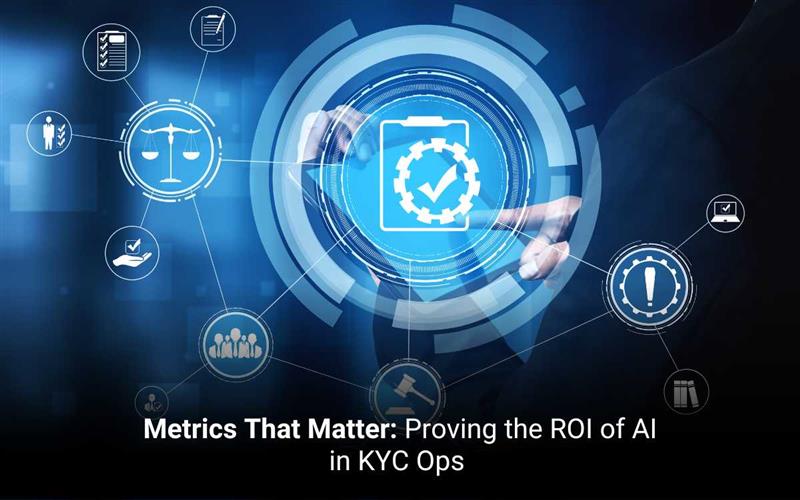Metrics That Matter: Proving the ROI of AI in KYC Ops

A financial institution is gearing up for a digital transformation. The compliance team is overwhelmed with manual document verification processes. The leadership decides to bring in AI to streamline KYC operations. With the transformation, the turnaround time is cut in half, allowing the team to focus on compliance tasks. But when the CFO asks, “What’s the actual return on this investment?”, silence follows. This is precisely the situation that you need to prove the ROI of AI in KYC ops.
FinTech’s are adopting AI-powered solutions for KYC to accelerate the process in compliance with regulations. However, stakeholders across compliance and finance expect more than operational numbers. They want ROI metrics that prove AI is delivering value.
In this piece, we’ll break down the ROI metrics that matter most in AI-powered KYC.
Key ROI Metrics for AI in KYC Operations
1. Customer Onboarding Time Reduction
One of the immediate benefits of AI in KYC is faster onboarding.
Metric: Average time to onboard a customer (before vs. after AI deployment).
Example: A payment gateway reduced onboarding time from 5 days to under 24 hours by automating ID verification and document analysis.
2. Compliance Cost Savings
AI reduces the reliance on manual labor for document review and risk assessment.
Metric: Decrease in operational costs tied to compliance processes.
Example: A global trade finance firm saved over $500K annually by reducing manual KYC checks.
3. Regulatory SLA Adherence
Meeting regulatory timeframes is critical to avoid penalties.
Metric: Percentage of KYC files processed within regulatory time limits.
Example: A corporate bank improved SLA adherence with AI-based case management systems and dynamic risk scoring.
4. Data Accuracy & Decision Consistency
AI brings consistency to risk classification and customer due diligence.
Metric: Accuracy rate of customer risk scoring vs. manual methods.
Example: A digital identity platform saw an improvement in consistency across KYC reviews, reducing rework and audit flags.
5. ROI Payback Period
Stakeholders need to know how soon the investment pays off.
Metric: Time taken to recover investment in the AI solution through cost savings and efficiency.
Example: A fintech onboarding platform achieved ROI in under 9 months through automation.
How Compliance KPIs Change with AI Implementation in KYC
Implementing AI in KYC reshapes the way compliance teams define success and measure performance.
1. From Volume Processed to Risk Quality
Before AI: Teams were judged by how many KYC files they processed.
After AI: The focus shifts to risk detection accuracy and the quality of outcomes.
Example: A cross-border payments company now tracks “percentage of high-risk customers accurately flagged by AI,” showing an improvement.
2. From Manual SLA Compliance to Automated SLA Adherence
Before AI, hitting turnaround and time targets was a manual process.
After AI: SLA compliance is driven by workflow automation and real-time case prioritization.
Example: A lending platform increased SLA adherence because of automated document verification and real-time alerts.
3. From Headcount Metrics to Operational Efficiency
Before AI: Performance was often measured by analyst output per day.
After AI: Efficiency is measured through the cost per case handled.
Example: A corporate banking KYC team handled more clients per analyst with no loss in compliance integrity.
4. From Reactive to Predictive Compliance
Before AI: Teams responded to red flags after an issue occurred.
After AI: Compliance becomes proactive, using real-time risk scoring and predictive monitoring.
Example: A global logistics fintech reduced high-risk onboarding cases by identifying fraud indicators earlier in the pipeline.
5. From Static Dashboards to Real-Time Insights
Before AI: Weekly or monthly compliance reports dictated decisions.
After AI: Real-time dashboards give clarity on risk trends, processing bottlenecks, and AI decisioning.
Example: An onboarding SaaS product built an AI-powered dashboard to monitor KYC exceptions in real-time.
Challenges of Integrating AI into Compliance Workflows
Here are the key challenges organizations must navigate.
1. Data Quality and Integration Issues
AI is only as good as the data it consumes. Many legacy compliance systems contain inconsistent customer data.
Challenge: Integrating clean, structured data from multiple sources is time-consuming.
Example: A trade finance platform struggled to unify customer records from five regional systems before AI could generate consistent risk scores.
2. Human-AI Alignment Gaps
AI can recommend decisions, but the final call often rests with compliance analysts.
Challenge: Training staff to trust and interpret AI outputs is an operational shift.
Example: A financial institution’s KYC team saw adoption lag due to a lack of training around AI-driven risk scoring.
3. Regulatory Uncertainty Around AI Usage
AI in compliance is evolving faster than regulations.
Challenge: Staying compliant in jurisdictions with conflicting AI governance rules can create legal exposure.
Example: A banking platform had to limit rollout of its AI KYC module in the EU pending GDPR-related legal clarification.
4. Measuring ROI in Hybrid Environments
Blended workflows with both AI and manual oversight make it harder to track ROI.
Challenge: Establishing clear ROI metrics such as time savings, cost per case, or error rate reduction is complex without full AI maturity.
Example: A SaaS KYC provider struggled to isolate AI’s contribution to onboarding speed because manual intervention was still involved.
5. Vendor Lock-in and Scalability
Many AI solutions are proprietary or rigid.
Challenge: Scaling across markets or adapting to evolving compliance rules becomes difficult.
Example: An Insurtech firm faced scalability issues when its AI KYC vendor couldn’t support new regulatory mandates.
How AI Ensures Better KYC Compliance
Here’s how AI ensures better KYC compliance.
1. Due Diligence for High-Risk Clients
AI helps streamline enhanced due diligence (EDD) by collecting and analyzing news, sanctions list, and ownership structures.
Example: A crypto exchange leveraged AI to screen politically exposed persons (PEPs) and beneficial ownership changes.
2. Reduced False Positives in Screening
AI models learn from past decisions and refine screening accuracy over time, reducing alert fatigue for compliance teams.
Example: A global payments platform reduced false positives, allowing analysts to focus on high-risk cases.
3. Continuous Monitoring Instead of Periodic Checks
Unlike traditional KYC, AI enables monitoring of customer profiles, enhancing compliance posture.
Example: A corporate lending platform embedded AI to track changes in customer behavior or profile in real-time.
4. Audit-Ready and Transparent Compliance
Modern AI solutions are now built with explainability, which is critical for regulatory audits.
Example: A financial services firm implemented AI that logs every compliance decision with traceable logic, reducing time for audits.
Conclusion
Adopting AI alone isn’t enough; being able to prove that it’s working is essential. That’s where ROI metrics come in. If your organization is planning to invest in AI for KYC, make sure you’re building your strategy around metrics that matter. Because in the eyes of the regulator, performance without proof is just potential.



